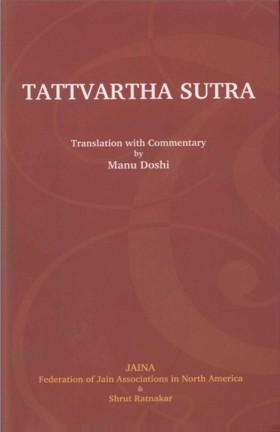05.29 Utpādvyaydhrouvyayuktam Sat
Audio: Sanskrit: उत्पादव्ययध्रौव्ययुक्तं सत् ।
Hindi: जो उत्पाद, व्यय और ध्रौव्य इन तीनों से युक्त है वही सत् है ।
05.30 Tadbhavavyayam Nityam
Audio: Sanskrit: तद्भावाव्ययं नित्यम् ।
Hindi: जो अपने भाव से (अपनी जाति से) च्युत न हो वही नित्य है।
05.31 Arpitanarpitasiddheh
Audio: Sanskrit: अर्पितानर्पितसिद्धे: ।
Hindi: प्रत्येक वस्तु अनेकधर्मात्मक है, क्योंकि अर्पित - अर्पणा अर्थात् अपेक्षा विशेष से और अनर्पित - अनर्पणा अर्थात् अपेक्षान्तर से विरोधी स्वरूप सिद्ध होता है।
05.29-31
English: The sutra 29 defines the term Sat. What arises, passes away and still continues to stay is Sat. This definition may seem amazing, because what arises and passes away has to be temporary and transient. How can such a thing continue to stay? Since the concept of constancy negates the concept of being transitory, how can both of them go together?
Such problems arise on account of the concept of absolute constancy enunciated by Sānkhya and other philosophies. But that concept is unrealistic, because everything is subject to change. It is the manifest experience that nothing stays in the same state or form forever. That does not even mean that everything is momentary as Buddhism contends. Had it been so, we could never identify an object as having seen or experienced earlier. If it entirely changes every moment, the next moment it would be beyond recognition.
The truth lies between these two extremes and for that purpose Jainism presents the concept of modified constancy. It states that everything remains constant within its properties, but its states go on changing. For instance, the soul is eternal and is always imbibed with its properties of knowing, perceiving etc. However, it assumes heavenly, human or other state from time to time. Similarly it may also assume a male, female, or hermaphroditic body. The assumption of any such state involves the termination of the previous state.
That logic also applies to inanimate objects. The clouds, for instance, arise on account of evaporation. As they are condensed, they give up that form and assume the form of rain. But during all such transformations, water remains constant. Thus every form is subject to arising and passing away. It is therefore correct to state that every thing retains its existence while undergoing changes in its states and forms.
In order to make this clearer sutra 30 specifies the Jain concept of constancy. It states that what stays within its properties and does not give them up is constant. This concept of constancy is relevant to make out how a matter can remain constant, while its states go on changing. It implies that every thing has two aspects, its inherent properties and its states or forms. The former remains constant and the latter continues to undergo changes.
The question would then arise, how to decide whether a thing is everlasting or ephemeral. Sutra 31 states that it depends upon the angle from which a thing is viewed. Everything and every aspect can be seen differently from different perspectives. Views arising from the different perspectives are relative and some of them, like being everlasting and ephemeral, can even be contradictory. The sutra thus relates to the multiplicity of views. It states that everything is constant from the absolute point of view, while from the practical point of view it is temporary.
If everything can be considered as everlasting from one viewpoint and transitory from the other, the question would be how to express such contradictory views simultaneously. Obviously it is not possible to express that way. This leads us to the third view that it is inexpressible. That logic can be taken further ahead. By combining inexpressibility with everlasting, transitory and everlasting cum transitory natures one after another, one can see that everything and every situation can be viewed from seven perspectives. That is termed as Saptabhangi.
 Acharya Umaswati
Acharya Umaswati
